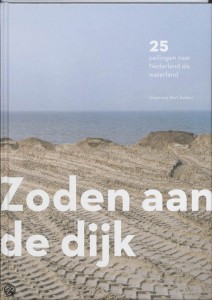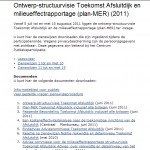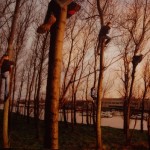There exists such a thing as the Structuurvisie Toekomst Afsluitdijk - a Structural View on the Future of…
Zoden aan de dijk
I’m reading Zoden aan de Dijk, which deals with the Netherlands from a watery point of view. The title is rather hard to translate: a zode is a sod of grass or turf, and dijk is of course the parent of the english dike or dyke. Sods are used to construct a dike , so “dat zet geen zoden aan de dijk” translates to “this puts no sods on the dike”. Which expresses a situation where an activity or solution may not be very effective or helpful.
Playing through this is the notion (trope?) that every inhabitant of a polder has to do his bit in dike construction and maintenance. If one person is not pulling his weight, the common good is endangered: a dike needs only one weak point to break. Even though Wiki credits it to the Church of the Latter Day Saints, the idea of decision making by common consent stems from the Dutch. We’ve started calling this decision making model the Polder Model. Being Dutch, we are both proud of the idea and decry it as a very very slow decision making process. All parties have to be consulted, which takes forever and a day, and feeble comprimises are agreed upon.
From the introduction, page 7 (my translation):
What moves people to go live in the mud of a swampy river delta, where wind and water have free rein and where one has to guard continuously against threats from river and sea? Apart from this question it is also very challenging to build on muck. Before any building can start, long piles have to be driven into the ground. A city like Amsterdam seems to be a project born of desperation. Adding insult to injury, the city was very hard to approach via a narrow thoroughfare by the island of Texel and over a shallow Zuiderzee. Until far into the nineteenth century all Amsterdam’s fresh water – needed for brewing – had to be shipped in from the countryside.
Each generation discovers this truth anew: defence against water will never know a final solution. Dykes, dams and sluices provide temporary solutions at best – water, land and climate follow their own regime. For the longest time it was presumed that Holland floated on water. The famed 16th century historian Ludovico Guicciardini knew this for a certainty: all of Holland is one big water mattress. Driving a cart or on horseback one could feel the underground shake and stir. The ultimate proof: the cow that sunk down its meadow in Haarlem, only to resurface in the river IJ. Drowned, of course. This is what Holland must stand for: Hollow Land. A more contemporary explanations is ‘Houtland’ – land that used to be covered with forest.
Reclaiming land from silt did not appeal to everone’s imagination. Was there not room enough for the first settlers among the sea dunes and on the partially wooded sandy soils a little further inland? How to cultivate this partially drained land? And above all: why?
As usual, ideology and common sense went hand in hand when the options this unlikely corner of Europe had to offer were exploited. These two forces were fundamental in shaping an area now so densly populated that it verges on a miracle – an area that seemed to be uninhabitable, but from which came an almost unimaginable number of riches. For soon the waterways that drained the area proved to be valuable means of transportation. Three quarters of the year the land-bound roads were unaccessible because of the weather. Whereas the waterways could be used throughout the year, providing a means of transport into the furthest corners of Europe. The strong and sometimes stormy wind filled the sails. This northwestern corner of Europe, situated between densely populated areas, begged for intensive trade connections. The inhabitants of the newly tamed land created marketplaces and facilities for transshipment, they themselves having little to offer by way of mineral riches and other products because of the unstability of their underground.
Later: I quite like the effort of translation. A not-so-easy puzzle, and a good update for the old vocabulary. So let’s do some more:
The scarcity of natural resources turned out to be a fallacy: once poldered dry, the soil turned out to be fat clay or peat. Which created attractive possibilities for growing crops and keeping cattle, and even for harvesting peat for fuel. This was, like the natural gas that came later,a source of prosperity: easy to harvest and abundantly available. The options this natural richess offered were taken up with alacrity. Once the land was exploited, going back was not an option.
At the start, large portions of the present Netherlands were above sea level. The way the water gave and take land had a certain balance. Where rivers had a natural way of adding material, this surplus was taken back from time to time by flooding. Man-made mounds and floodhills became safeguards against the recurring violence of the sea and rivers. Drainage was employed to create arable land. Drainage was usually started by digging ditches draining off to a natural watercourse, for example a river. When no natural watercourse was at hand, one was dug, creating an interlocking system of waterways. This system drained large portions of land and made it arable. It also – until the present day – made the soil subside. So the land became lower and lower, and more vulnerable to flooding. To counteract this subsidence the construction of dikes, sluices and windmils became necessary, as well as the strengthening of dunes. Without dunes and dykes a major storm coinciding with a spring tide, or with high water levels in the rivers, would inundate about 65% of the Netherlands.
Sea and river defence activities got an extra stimulus from a new way of thinking dating from the early middle ages: apart from the practical advantages, a notion was born of man as God’s co-creator. Because of this new way of thinking, borrowed from theology, reclaiming land became an activity sancioned by God, a notion that has never really left Dutch society. However, this laudable idea soon gave way to a more common greed. Rulers and overlords saw poldering as an attractive way to enlarge their territories. Which is why poldering experts, at the end of the middle ages, could earn real money.
In this spirit Vondel, that prince of Dutch poets, sang the praises of the Beemster polder in 1612. He lauded the new possibilities for sport and recreation the Amsterdam elite had gained, creating their very own little paradises at Beemster. The elite was present at the formal dinner given to celebrate the finished project: principals, investors and bankers feasted with the Prince of Orange. Leeghwater, the canny civil engineer that masterminded the operation, was not a dinner guest. He was invited to help serve the meal. Which was deemed honor enough for one that was – after all – a labourer, thoug admittedly a superior one.
page 10: How was it possible that an amphibious creature disguised as man – a figure of speech much used abroad – could improve his standard of living to such a degree? Become so wealthy? And why did the Dutch try to hide their prosperity behind a make-believe austerity in person and in way of life? Was their tendency to live in and on the water not an unnatural act in itself? The unnatural character of the Low Countries was perceived abroad from the very moment the Dutch started their poldering. An obscure reference in Dante’s ‘Divina Commedia’, written at the beginning of the 14th century, accentuates this non-conformistic behaviour in an alarming way as a direct attack on creation and Creator.
Vergil and Dante, sauntering through hell, arrive at a heat-radiating sandy desert situated in the third ring of the seventh circle. It is the place where those that sinned against nature meet their punishment. Sinners burn with a heat so great it has to be tempered by a canal and a dam in order to accommodate visitors . And to make clear how this moral topography works, Dante compares it to the dikes in Vlaanderen: “As the Flemish between Cadzand and Brugge, fearing the flood that springs on them, construct dikes to stem the tide (…) so there were dams along this canal, even though their builder, whoever it was, made them less deep and wide.”
At the core of this comparison is the notion of poldering as being against nature. Creating dry land by digging ditches and building dikes merits the term ‘unnatural’. Creating land was the province of God Himself, and the sin of pride was was visited upon those thinking themselves to be on His level. People building dikes must be unnatural sinners and greedy profiteers, trying to maximise their gain, trampling over their fellow creatures in their search for maximum profit.
page 12: Counteracting the idea of the polders being branches of hell, Dutch legend started supporting the co-creation theory. Stories were told of flood-propelled cradles stopping holes in a dike, baby and all. Some tales added a cat, sitting on top and steering the little vessel. Like Mozes – washed ashore in a cradle – these babies were destined to take the lead in restraining the water. (..) Stories of ships being sunk in a breach of a dike inspired real acts of heroism – and such deeds are documented more than once.
page 13: Doing battle with the water was reported to have caused an irrational fear of stains, an obsession to remove all blemishes from windows, sidewalks and even the soul. Which is why, a foreigner maintained, the jenever was invented, an acrimonious fluid cleansing the body’s ducts. These convictions were held up by science until the eighteenth century: the character of those living in the Low Countries was seen to be shaped by a superabundance of water. Living in a swamp-like delta, soaked with rain, the Dutch brains became sponges. Lowlanders were good at goblling up ideas and reproducing them, but really bad at creating new notions.
A nation of copycats, therefore, that turned everything they met with to advantage and made money from trade hand over fist. For which they paid the price, for deep thought does not happen in a waterlogged head. Supporting this thesis, the watery people produced the best painters for ages. For they only had to squeeze images from their spongy brains and paint them ‘to the life’. Writers they were not, for this required abstract thought, which sponges-for-brains did not support.
| « Plus / Minus – making of | <-- previous post | next post --> | Crossed » |
|---|








